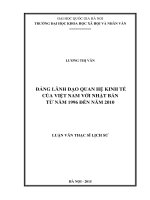Quản trị kinh doanh luôn là một trong những ngành hấp dẫn các bạn trẻ năng động, đặc biệt trong xu thế hội nhập kinh tế Quốc tế của Việt Nam những năm gần đây. Việc tìm hiểu rõ về ngành Quản trị kinh doanh giúp bạn định hướng nghề nghiệp tốt hơn trước kh
Bạn đang xem bản rút gọn của tài liệu. Xem và tải ngay bản đầy đủ của tài liệu tại đây (912.19 KB, 14 trang )
Chapter 2
Traits, Behaviors, and
Relationships
1
Chapter Objectives
Identify personal traits and characteristics that are
associated with effective leaders.
Recognize autocratic versus democratic
leadership behavior and the impact of each.
Know the distinction between people-oriented and
task-oriented leadership behavior and when each
should be used.
Understand how the theory of individualized
leadership has broadened the understanding of
relationships between leaders and followers.
Recognize how to build partnerships for greater
effectiveness.
2
The Trait Approach
Traits: the distinguishing personal
characteristics of a leader, such as
intelligence, honesty, self-confidence,
and appearance
Great Man Approach: a
leadership perspective that sought to
identify the inherited traits leaders
possessed that distinguished them
from people who were not leaders
3
Ex. 2.1 Personal Characteristics of
Leaders
Personal Characteristics
Energy
Physical stamina
Intelligence and Ability
Intelligence, cognitive ability
Knowledge
Judgment, decisiveness
Personality
Self-confidence
Honesty and integrity
Enthusiasm
Desire to lead
Independence
Social Characteristics
Sociability, interpersonal skills
Cooperativeness
Ability to enlist cooperation
Tact, diplomacy
Work-Related Characteristics
Drive, desire to excel
Responsibility in pursuit of
goals
Persistence against
obstacles, tenacity
Social background
Education
Mobility
4
Behavior Approaches
Autocratic: a leader who tends to
centralize authority and derive power
from position, control of rewards, and
coercion
Democratic: a leader who delegates
authority to others, encourages
participation, relies on subordinates’
knowledge for completion of tasks, and
depends on subordinate respect for
influence
5
Ex. 2.2 Leadership Continuum
Subordinate-Centered
Boss-Centered
Leadership
Leadership
Use of authority by manager
Area of freedom for subordinates
Manager makes
Manager presents
Manager
Manager
decisions and
ideas and invites
presents
permits
announces it
questions
problems,
subordinates
gets sugg.
to function
makes
within limits
Manager “sells”
decision
Manager
changes
Manager defined by
presents tentative
defines limits,
superior
decision subject
asks group
to change
do make
decision
6
Ohio State Studies
Consideration: the extent to which a
leader is sensitive to subordinates,
respects their ideas and feelings, and
establishes mutual trust
Initiating Structure: the extent to
which a leader is task oriented and directs
subordinates’ work activities toward goal
achievement
7
University of Michigan Studies
Employee-centered: a
leadership behavior that displays a
focus on the human needs of
subordinates
Job-centered: leadership behavior in
which leaders direct activities toward
efficiency, cost cutting, and scheduling,
with an emphasis on goals and work
facilitation
8
Ex. 2.3 The Leadership Grid Figure
®
1,9
9,9
Country Club Management
Team Management
Concern for People
High
5,5
Middle-of-the-Road
Management
Impoverished Management
Authority-Compliance
1,1
Management
9,1
Low
Low
Concern for Results
High
9
Ex. 2.4 Themes of Leader Behavior
Research
People-Oriented Task-Oriented
Ohio State University
Consideration
Initiating Structure
University of Michigan Employee-Centered
Job-Centered
University of Texas
Concern for
Production
Concern for People
10
Ex. 2.5 Stages of Development of
Individulized Leadership
1.
Vertical Dyad Linkage
Leaders’ behaviors and traits have different
impacts across followers, creating in-groups and
out-groups
2.
Leader-Member Exchange
Leadership is individualized for each subordinate.
Each dyad involves a unique exchange
independent of other dyads.
3.
Partnership Building
Leaders can reach out to create a positive
exchange with every subordinate. Doing so
increases performance.
4.
Systems and Networks
Leader dyads can be created in all directions
across levels and boundaries to build networks
that enhance performance.
11
Ex. 2.6 Leader Behavior Toward InGroup versus Out-Group Members
In-group
Discusses objectives;
gives employee freedom to
use his or her own
approach in solving
problems and reaching
goals
Listens to employee’s
suggestions and ideas
about how work is done
Treats mistakes as
learning opportunities
Out-Group
Gives employee specific
directives for how to
accomplish tasks and
attain goals
Shows little interest in
employee’s comments and
suggestions
Criticizes or punishes
mistakes
12
Ex. 2.6 (contd.)
In-Group
Gives employee interesting
assignments; may allow
employee to choose
assignment
Sometimes defers to
subordinate’s opinion
Praises accomplishments
Out-Group
Assigns primarily routine
jobs and monitors
employee closely
Usually imposes own
views
Focuses on areas of poor
performance
13
Leader-Member Exchange
An individualized leadership model that
explores how leader-member relationships
develop over time and how the quality of
exchange relationships impacts outcomes
14









